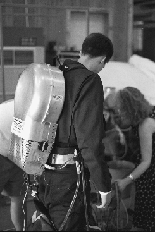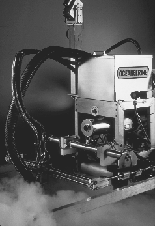
D&D technologies promote worker safety
Two technologies sponsored by the decontamination and decommissioning focus area approach the question of worker safety from different angles. The Advanced Worker Protection System, developed by Oceaneering Space Systems, creates a safer working environment through a liquid air-based, self-contained breathing and cooling system that increases the time workers can comfortably and safely accomplish D&D tasks. The Remote Operated Vehicle with CO2 Blasting System, or ROVCO2, was developed by Oceaneering Technologies and reduces worker exposure through a remotely controlled, carbon dioxide or dry ice blasting system for surface decontamination.
Advanced Worker Protection System
Some of the work involved in the decommissioning and decontamination of U.S. Department of Energy sites will be performed by workers in protective suits and respirators. Because most protective suits retain body heat, workers can experience heat stress in as little as 20 minutes. Workers require a "cool-down" of approximately one hour to recuperate. When the time for rests is added to time required for donning, doffing, and decontamination, the work day is less than 50 percent efficient.
The AWPS is not only a self-contained breathing apparatus, it also relieves heat stress. Liquid air cools the body, enabling a worker to stay on task up to two hours without requiring a cool-down period.
 The liquid air is stored in a vacuum-jacketed vessel called a dewar. The dewar is held in a backpack, which also holds a pressure regulator and a hose through which air is delivered to a face mask. The other components of the AWPS are a full-body, liquid-cooling garment; and outer garment options of either a Level A (vapor-proof) suit or a Level B (splash-proof) suit.
The liquid air is stored in a vacuum-jacketed vessel called a dewar. The dewar is held in a backpack, which also holds a pressure regulator and a hose through which air is delivered to a face mask. The other components of the AWPS are a full-body, liquid-cooling garment; and outer garment options of either a Level A (vapor-proof) suit or a Level B (splash-proof) suit.
The liquid air is fed through a heat exchanger which uses water warmed by the wearer's body to vaporize the liquid air for breathing. The heat exchanger also cools the water to control body temperature. The air is regulated to the appropriate pressure and delivered to the face mask. The cooled water is delivered to the full-body cooling garment. The amount of cooling can be controlled by the wearer. As the wearer breathes harder during higher work rates, more cooling will automatically be provided. A recharge station is required to fill the dewar on the AWPS with liquid air. The present design allows this recharge station to be retro-fitted to standard self-contained breathing apparatuses in use today.
Phase I development and testing of the AWPS prototype has been completed. During tests of the AWPS, workers performed tasks for an average of 75 minutes as compared to an average of 25 minutes for workers wearing conventional, self-contained breathing apparatuses. Based on the higher productivity rates of workers suited in the AWPS, it is estimated that a savings of 40% can be realized by moving away from use of conventional protective suits and respirators.
Because testing times for the AWPS were limited by fatigue, due to the weight of the backpack, one of the design modifications during Phase II will be reducing the weight of the unit. Phase II plans also include development of pre-production units, certification by the National Institute of Occupational Safety and Health, and a site demonstration in the summer of 1996 at a U.S. Department of Energy national laboratory.
Remote Operated Vehicle with Carbon Dioxide (CO2) Blasting System
 The ROVCO2 System is an efficient way of decontaminating large floor areas while creating a minimum amount of waste for disposal. The system reduces worker exposure by remote operation and increases productivity with automation.
The ROVCO2 System is an efficient way of decontaminating large floor areas while creating a minimum amount of waste for disposal. The system reduces worker exposure by remote operation and increases productivity with automation.
The blasting system is mounted on a six-wheeled vehicle that is operated remotely with up to 300 feet of umbilical. The system removes surface contaminants from floors using a CO2 (dry ice) blasting system. The removed debris, contaminants, and blasting gases are contained and vacuumed up at the workhead. The vacuum system deposits the debris and contaminants in a drum and transfers the gases, including the CO2, through an onboard filter.
The cold test of the ROVCO2 System concluded in October at Oceaneering in Upper Marlboro, Maryland. Blasting effectiveness, blasting efficiency, and system reliability were evaluated. Oceaneering is working with the Office of Science and Technology to establish an appropriate hot site for initial ROVCO2 operations. Current choices are the K-29 building at the Oak Ridge K-25 Site in Tennessee and the Plutonium Finishing Plant at Hanford in Richland, Washington.





 The liquid air is stored in a vacuum-jacketed vessel called a dewar. The dewar is held in a backpack, which also holds a pressure regulator and a hose through which air is delivered to a face mask. The other components of the AWPS are a full-body, liquid-cooling garment; and outer garment options of either a Level A (vapor-proof) suit or a Level B (splash-proof) suit.
The liquid air is stored in a vacuum-jacketed vessel called a dewar. The dewar is held in a backpack, which also holds a pressure regulator and a hose through which air is delivered to a face mask. The other components of the AWPS are a full-body, liquid-cooling garment; and outer garment options of either a Level A (vapor-proof) suit or a Level B (splash-proof) suit.

